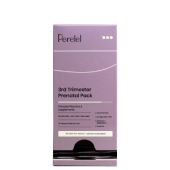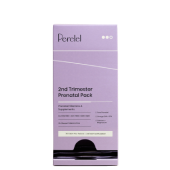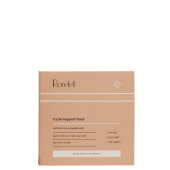Let’s start off with an important fact: Everyone’s menstrual cycle is different. While the average cycle length is roughly 28 days, some of us hover closer to 21 days, while others can have cycles as long as 35 days. For some of us, our periods are like clockwork, coming and going around the same time every month. For others, they can be more unpredictable.
Slight variations in cycle length (and flow!) are completely par for the course. But if you notice major inconsistencies in length, flow, or start date—or cessation of your period altogether—it’s time to start investigating, as something else could be at play. Disruptions in your cycle can be the result of stress, hormonal birth control, or an underlying condition—but since your cycle is a crucial biomarker for your health, getting to the bottom of any irregularity is key.
To get the full picture on irregular periods, we sat down with Dr. Caitlin O’Connor, a naturopathic doctor who specializes in women’s health. Read on to learn what’s normal, what’s not, and when symptoms are a sign to dig a little deeper.
Let’s start with the basics: What do we categorize as an "irregular period?"
“Irregular periods are any variation from typical cycle expectations,” says Dr. O’Connor.
While normal menstrual cycles last around 21 to 35 days with four to seven days of bleeding, it’s important to know that irregularities can exist within that time frame, too. According to Dr. O’Connor, “If someone has had a shift in their pattern—for example, getting their period every 24 days instead of their usual 28 days—that could be irregular for them, and they may want to investigate why.” She adds that cycles can also be defined as irregular if there is bleeding or spotting in between cycles, or if cycle timing varies by more than two to three days from month to month.
It’s important to know that if your period is irregular, it typically means that your ovulation is irregular. The hormones of regular ovulation are good for your long-term health. A very irregular period, especially during your fertile years, can make it difficult to get pregnant.
It can also cause too frequent menstruation or lower levels of hormones, putting you at risk of:
-
Bone loss (a.k.a. osteoporosis)
-
Iron deficiency
-
Heart disease
-
Fibroids
-
PCOS
There are also certain conditions related to irregular menstruation, like amenorrhea—also known as the absence of menstrual periods. Primary amenorrhea refers to when someone assigned female at birth doesn’t get their first period by age 15. Secondary amenorrhea, on the other hand, is when a woman who already menstruates—but is not pregnant, breastfeeding, or going through menopause—doesn’t get a period for 90 days or more. (For context, about one in 25 women will experience amenorrhea at some point in their lives, so you’re definitely not alone.)
Abnormal uterine bleeding, defined as bleeding that lasts longer than usual or that occurs at an irregular time, is another related condition. If you notice your menstrual bleeding is heavier or lighter than usual, and occurs often or randomly, it’s a good idea to touch base with your health care provider. Same goes for symptoms of amenorrhea.
Shop the Article:
- Clinically-Proven

Hormonal Balance Support*
$46.95
/ Month
- Promotes healthy ovulation*
- Promotes regular menstrual cycles*
What are the causes of irregular periods?
“The causes are really multifactorial,” explains Dr. O’Connor, emphasizing that the first step in treatment is getting to the root of the issue—a process your doctor can help guide. “Irregular periods can be related to underlying health conditions such as polycystic ovary syndrome (PCOS) or thyroid disorders, or they can be spurred on by lifestyle factors like stress, dieting (low carbohydrate and low calorie diets in particular), over-exercising, rapid weight loss, or disrupted sleep.”
That said, here are some common causes to keep in mind:
Medical conditions:
-
Endometriosis
-
Pelvic inflammatory disease
-
Polycystic ovarian syndrome
-
Hypothyroidism
-
Hyperthyroidism
Lifestyle factors:
-
Stress
-
Illness
-
Weight gain or weight loss
-
Dieting or eating disorders
-
Exercise routines that result in very low body fat
Other causes
-
Birth control pills
-
Certain medications (steroids, blood thinners)
Your ovulation and period can also become irregular during different life stages, like puberty, the postpartum period, and perimenopause.
Keep in mind: a real period is different from the withdrawal bleed that you get on hormonal birth control, which can be irregular. It’s also different from spotting between periods, which can be caused by endometriosis and fibroids.


What are your
stage-specific needs?
Let us personalize your vitamin routine in 60 seconds.
What is the impact of stress on my menstrual cycle?
The part of your brain that controls your period is very sensitive to cortisol, the hormone your body makes when you’re under stress. If you are going through a lot, you might experience missed, light, or late periods.
How does my life stage impact my menstrual cycle?
Irregular periods can show up across our lives. It’s not unusual for people’s periods to start off irregularly during puberty. That’s because your body is gradually adjusting to ovulation and your brain, which regulates your period, is still maturing.
After having a baby, it takes a while for your period to return and it’s often irregular because your hormones are still in flux.
During perimenopause, your cycle gets irregular as your sex hormones start to decline. You might notice more spotting between periods and heavy bleeding in combination with a short or long cycle.
Are there ways to lower the risk of having an irregular period?
In general, Dr. O’Connor says avoiding restrictive dieting and over-exercising, managing stress, and getting adequate sleep are good places to start.
How are irregular periods diagnosed?
If you sense changes, start tracking when your periods begin and end. Note your symptoms, the amount of flow, and any other changes you’re noticing. To diagnose an irregular period, your doctor will ask you about your cycle and medical history, then perform a physical examination, including a pelvic exam.
How are irregular periods treated?
Again, it depends on the underlying cause. Some options center around lifestyle changes, while others include medications like hormonal birth control. That said, it all depends on what’s going on with your body.
Dr. O’Connor’s advice? Start with a professional. “Anyone with menstrual irregularities should have blood work done with their health care provider to see what the root cause might be. They should also carefully assess lifestyle factors to address anything that might be contributory. Based on the cause, there are many treatment options.” (She added that many providers will prescribe hormonal contraceptives before looking for underlying causes, but there are plenty of others who are willing to individualize treatment, should you prefer a more holistic route.)
Take PCOS, for instance—there are both pharmaceutical and naturopathic approaches to shift hormones and regulate ovulation. For someone who is under-eating, adding more calories or fat or carbs might be necessary; those who are over-exerting themselves may need to add rest days or modify their workouts or training schedule. If someone is underweight or has insulin resistance, it may require work with a nutritionist and a dietary change. Our Hormonal Balance Support formula was created by leading doctors with symptoms like irregular cycles in mind—with ingredients like DIM and Myo-Inositol to promote hormonal balance and estrogen production.
Regardless, Dr. O’Connor says, “Step one is to get the medical history, physical exam, and labs done to figure out the why.”
Learn more about PCOS and what other symptoms to look for.

theFolio in Your Inbox
Sign up to receive doctor-backed, stage-specific content in your inbox each week.
This article is for informational purposes only. It is not, nor is it intended to be, a substitute for professional medical advice, diagnosis, or treatment and we recommend that you always consult with your healthcare provider. To the extent that this article features the advice of physicians or medical practitioners, the views expressed are the views of the cited expert and do not necessarily represent the views of Perelel.























